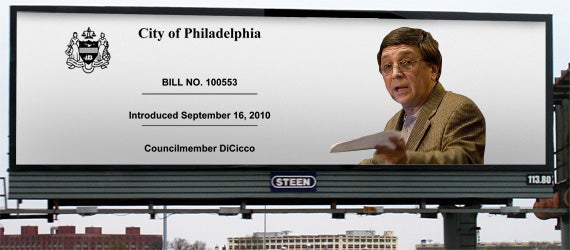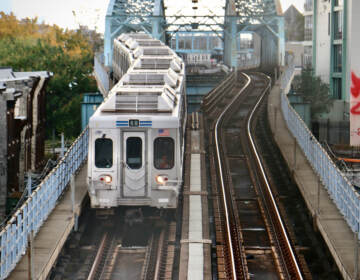How bill on I-95 condemnation corridor came to be

Pending city council legislation that would allow owners of the typical, one-dimensional billboards set to be removed for the I-95 expansion to replace them with flashier, double-sided, electronic signs was not authored by First District Councilman Frank DiCicco, who introduced it last week.
Zoning Bill No. 100553 originated with Terry Steen, president of Steen Outdoor Advertising, a local leader in the billboard business whose signs dot that highway.
Here’s the play-by-play.
Steen first approached Councilwoman Joan Krajewski’s office in early August in hopes of setting up a meeting, and then later sent his version of the bill by email to her chief of staff, Chris Creelman. Creelman, who said he didn’t know who Steen was, told him he was not comfortable setting up a meeting about the legislation with Krajewski.
On Aug. 16, Creelman sent the draft of the legislation to William Kramer, director of the Philadelphia City Planning Commission’s development planning division, to get his opinion on it. Creelman said he took that step for two reasons. “It was unusual, to say the least,” for a businessman to send a bill to the councilwoman’s office and ask that she introduce it, and zoning issues aren’t his forte.
Kramer said in a PlanPhilly phone interview that he not only reviewed the ordinance drafted by Steen, but sent it around to others to get their opinion on it. The bottom line: Planners had some big concerns. In part of an email chain obtained by PlanPhilly, Kramer told Creelman: “Obviously this is an attempt for the non-accesssory sign companies to create loopholes in order to allow for the continued existence of signage (along) the I-95 corridor.”
At this point, DiCicco stepped in and introduced the legislation.
View Steen billboards locations in a larger map
A map depicting the general location of outdoor advertising firm Steen’s billboards along I-95, according to a Society Created to Reduce Urban Blight inventory taken in 2007.
The back story. PennDOT will need to condemn 21 to 25 billboards between I-676 and Cottman Avenue, PennDOT spokesman Eugene Blaum said. But there is more to it than outdoor advertising. The bill would also apply to buildings, parking lots, and other existing uses, allowing owners to rebuild anywhere that is within 350 feet of their former location and 200 feet from either side of the expanded highway right of way without going through the usual zoning permitting process.
That’s regardless of the zoning that exists in the area the displaced property owner choses to relocate to, unless the new site is in a residential district. A billboard or building would have to remain the same size as it is currently, but the bill does not address other potential changes, ushering in the ability to build an electronic billboard to replace a standard one.
Deputy Mayor Alan Greenberger, who oversees planning, said that hypothetically, a business wouldn’t have too move far to cross into a completely different zoning classification – one in which it is not meant to exist.
And it seems that a business that is operating legally with a variance could move within the proposed I-95 Condemnation Corridor and start up again without applying for another variance. “They could redevelop without oversight,” he said.
The bill says, in its legislative findings section, that its purpose is “to encourage and aid in the continuation of business or other uses with minimal dislocation or interruption” and to thus save jobs for residents and tax revenue for the city.
Nowhere in the bill do the words “billboard” or “outdoor advertising” appear. But with one exception, everyone PlanPhilly interviewed for this article referred to it as the billboard proposal. Kramer told PlanPhilly that based on what he was looking at when Creelman asked for the review, which appeared to be the same language introduced by DiCicco last week, the bill presented serious legal issues and seemed to trump existing zoning. “That bothered me,” he said.
Kramer also thinks the bill carries with it some unintended consequences that could result in buildings taken for the highway being rebuilt in areas that are not zoned for that level of density. Kramer said he told Creelman he would be willing to meet with Steen to discuss his concerns, but no one took him up on the offer.
Creelman said that his understanding was that Kramer had sent the proposal to the city’s legal department for review, and he and the councilwoman were waiting to hear the results of that review so that she could use that feedback to decide whether or not the legislation was a good idea. “We didn’t have time to fully analyze it before it was introduced by Councilman DiCicco,” Creelman said. “I would assume he was not happy with our response time, so he took it to another office.”
Kramer said he was also surprised to learn the bill had been introduced by DiCicco, especially since the issues the bill addresses seem to be more prevalent in Krajewski’s district.
Sean McMonagle, DiCicco’s legislative aide, said that either Steen or someone representing him had contacted DiCicco about the bill about two weeks ago. DiCicco called McMonagle to ask if he was working on anything like that, and McMonagle said no. Considering that so much of I-95 runs through Krajewski’s office, he figured her team might be working on it. He called them and was told the proposal had been sent to the legal department for review.
Last week, DiCicco called McMonagle again. The councilman was at a meeting, and either Steen or a representative of his company approached him again about the bill. McMonagle received the proposed legislation from an attorney representing Steen, he said.
McMonagle said that receiving a legislative proposal that was written by someone else didn’t trouble him – that’s pretty common, he said, and it’s the content that matters. DiCicco doesn’t yet know enough about what the content means to have a position on the legislation, McMonagle said, and introduced it to get it on the table for discussion.
“He does that frequently,” McMonagle said.
Before deciding whether to support the legislation he introduced, both DiCicco and McMonagle want to see the results of the review now happening in the planning and legal departments, McMonagle said.
That more in-depth review is happening because planning staff added a last-minute item to Tuesday’s Planning Commission meeting. Whenever a zoning bill is proposed, the planning commission has 30 days to review it and make a recommendation to city council. If the commission doesn’t act, it is deemed approved. Planning staff came to the commission with serious concerns about the bill, and a recommendation that commissioners use the city charter provision that allows them to tack on an additional 45 days to review a proposal. If the commission hadn’t done that, the 30 days would have expired before their next meeting.
DiCicco was in Harrisburg Wednesday, but McMonagle said he has some concerns about the bill that he intends to share with his boss – ones very similar to concerns raised at the Planning Commisison meeting. “It sounds to me like we would be giving (outdoor advertising companies) free reign to construct a new billboard,” McMonagle said.
And he also noted that anyone whose billboard, building or other property is condemned as a result of the highway expansion will be paid for that loss by the state. McMonagle said he’s not sure it makes sense for the city to compensate the property owners a second time by clearing zoning hurdles they might otherwise need to jump in order to rebuild.
Mary Tracy, Executive Director of Philadelphia’s Society Created to Reduce Urban Blight (SCRUB) and president of Scenic America, a national organization with similar goals, said she knows of no other legislation like this in the country.
Tracy, whose Philadelphia organization has spent years working on sign-related issues, said that many of the billboards have been grandfathered in, but do not conform to current zoning laws – in technical terms, they are a non-conforming use.
“When that’s the case, when things go down, they cannot go back up again,” she said. “The blight of these signs has been an eyesore, and now they finally have to come down, and we’ve got a city councilman introducing legislation to allow them to go back up.”
Terry Steen could not be interviewed today – he was stuck on an airport runway in Phoenix. But Terry Lewis, print division operations manager, returned a call for him.
Lewis said that Steen is a big company that is about more than billboards. And the proposed legislation is also about much more than billboards.
Steen owns real estate and does development. Lewis said he’s not been involved with the proposed legislation, but he believes Steen is thinking more about a mini-storage facility the company owns than its billboards.
Lewis said he’s been around Philly long enough to have seen businesses that were taken through condemnations for other projects and never reopened because they were unable to meet newer zoning codes.
“This is not a billboard issue,” Lewis said. “This is about saving businesses for Philadelphia.”
Greenberger said he wants to see more information about how many properties could potentially be impacted by the proposal, and get more clarity on what the legal and planning ramifications of its language are.
A meeting to discuss the legislation with DiCicco is in the works, Kramer said. City Council could hold a hearing, but it cannot vote on the legislation until the Planning Commission’s newly extended 75-day review period is over, or the commission makes a recommendation to council.
Kramer said that while the review continues, “I don’t hold out a lot of hope for us supporting this.”
Contact the reporter at kgates@planphilly.com
WHYY is your source for fact-based, in-depth journalism and information. As a nonprofit organization, we rely on financial support from readers like you. Please give today.






